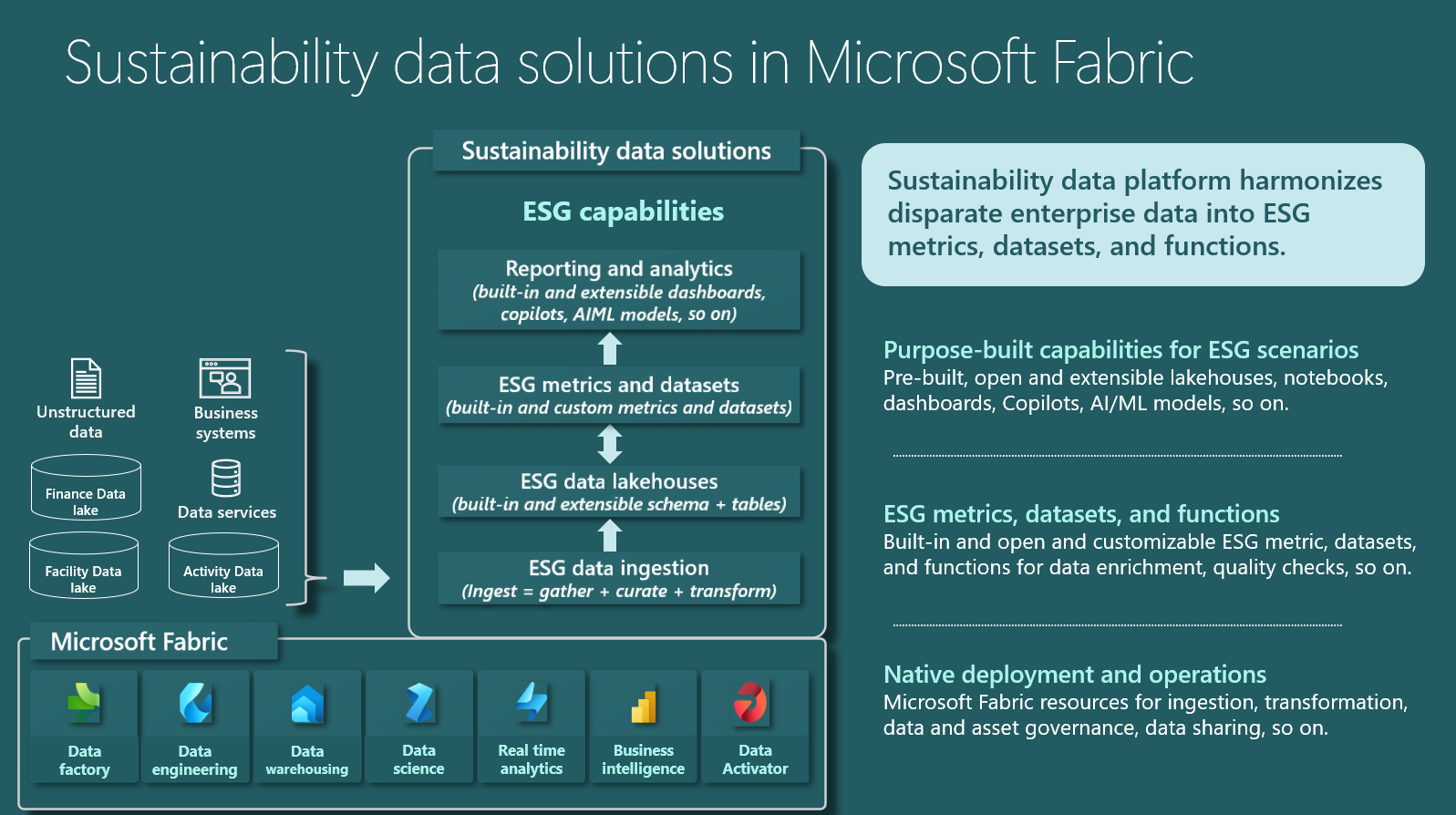Introduction to Sustainability data solutions in Microsoft Fabric
For organizations to solve the environmental, social, and governance (ESG) challenges, they need to collect and transform disparate data into standard-driven and analysis-ready data. This data transformation helps support the sustainability use cases.
Sustainability data solutions in Microsoft Fabric offer unique capabilities to ingest, harmonize, and process disparate ESG data for specific sustainability scenarios. With this solution, organizations can build a comprehensive data estate, centralizing and transforming data from across business units and supply chains into a standard schema. Organizations can use this data estate for advanced analytics and reporting. For more information, see Overview of Sustainability data solutions in Microsoft Fabric.
Sustainability data solutions in Microsoft Fabric architecture
Microsoft Fabric is an all-in-one analytics solution for enterprises. It covers data movement to data science, Real-Time Analytics, and business intelligence. It offers a comprehensive suite of services, including data lake, data engineering, and data integration, all in one place. For more information, see Get started with Microsoft Fabric.
Sustainability data solutions in Microsoft Fabric empower your organization to bring together ESG data from data sources, such as, business systems, unstructured data, semi-structured data, sensor data, and non-Microsoft datasets. Then, organizations can standardize the data by using the ESG data model to build a centralized ESG data estate. It consists of unique capabilities that provide prebuilt and preconfigured Fabric resources. These resources include data stores in the form of data lakes, prebuilt notebooks, and dashboards to ingest, process, aggregate, and display data for various ESG scenarios. The Microsoft Fabric resources that are associated with each capability are deployed to a Fabric workspace in your tenant, and you can set up the resources for your sustainability needs.
Important terminology in the Fabric architecture includes:
Interoperability for sustainability - Uses Microsoft Fabric resources for data ingestion, transformation, governance, and sharing. These components integrate unstructured data from various sources into Microsoft OneLake.
Microsoft Fabric - Helps you manage your data in one place with a suite of analytics experiences that work together, including Microsoft Azure Data Factory, Synapse Data Engineering, Synapse Data Warehousing, Synapse Data Science, Synapse Real-Time Analytics, and Business Intelligence using Microsoft Power BI, and Data Activator.
OneLake - Stores and transforms data into a standard format by using a sustainability analytical schema.
Sustainability data solutions in Microsoft Fabric - Helps you ingest, transform, and manage your data in OneLake. The capabilities of this solution include:
ESG data estate
Environmental data and insights
Environmental, Social, and Governance metrics (preview)
Social and governance insights (preview)
Microsoft Azure emissions insights
Sustainability data solutions capabilities
Sustainability data solutions in Microsoft Fabric have the following capabilities:
ESG data estate - This capability allows you to centralize and transform disparate data into one sustainability data lake that conforms to a standardized environmental, social, and governance (ESG) schema. For more information, see ESG data estate.
Microsoft Azure emissions insights - This capability helps you report and analyze Microsoft Azure emissions data by collecting and processing the emissions data in the ESG data lake. For more information, see Microsoft Azure emissions insights.
Environmental data and insights - This capability helps you build custom insights for carbon, water, and waste by connecting to your data in Microsoft Sustainability Manager. For more information, see[Environmental data and insights] (/industry/sustainability/sustainability-data-solutions-fabric/environmental-data-insights-overview).
Social and governance insights (Preview) - This capability allows you to generate social and governance insights from disparate social and governance data in the ESG data lake. For more information, see Social and governance insights.
Environmental social and governance metrics (Preview) - This capability allows you to compute, visualize, and analyze ESG metrics for regulatory standards like Corporate Sustainability Disclosure Regulation (CSRD) by using prebuilt and custom metric definitions. For more information, see Environmental social and governance metric.



